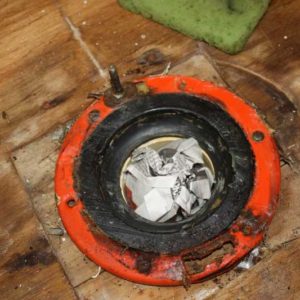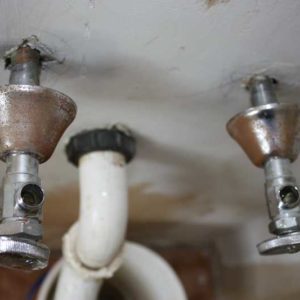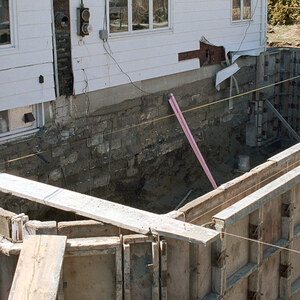Hi.
<!—-><!—-> <!—->
Vanity Shut-offs question (see photo): <!—-><!—->
I would like to replace these shut-off valves that are under my vanity because they are leaking. These are the kinds that are sweated onto that stub of ½” copper pipe you see barely sticking out of the wall. These are chrome plated ones made by Brasscraft.
<!—-> <!—->
1. Can I just un-sweat the existing connection and pull of the old valve assembly (chrome plated tube and valve)? Then clean the copper pipe of all old solder and sweat on a new Brass craft shut-off valve assembly just like the old one?
OR
2. Can I just cut thru the chrome plated tube, clean it, sweat on a short copper tube (by sliding it into the left-over chrome plated tube), then attach a new shutoff valve to this new copper tube I’ve just attached (effectively making the old chrome plated tube a connector)? Will the chrome plating interfere with the sweating process?
<!—-> <!—->
The second choice seems to me the easier since I won’t have to open up the drywall to get to clean copper tubing (since they are so close to the wall) for proper sweating.
<!—-> <!—->
Toilet flange question (see photo):<!—-> <!—->
About the toilet flange…I would like to clean the flange of the old wax. Is there a solvent or something I can use to thoroughly clean that? The flange is pretty sound even though there is some rust around the toilet/Johnny bolt slots. I want to clean and then spray this flange with a special rust neutralizing spray paint that I’ve use in the past with great success on other projects. But I don’t want the old wax to interfere with the paint.
<!—-> <!—->
Thanks to all in advance, I appreciate your help everyone.




















Replies
Try to unsweat the existing valve. Don't try to incorporate the chrome sleeve of the existing valve as part of the new plumbing.
If you can cut the escutcheon away it might give you a better visual as to how much copper you have to work with. Depending on the length of the valve's sleeve, you might be able to just cut the copper.
Regardless, if replacing with another brasscraft valve, go for a 1/4 turn ball valve instead of a multi-turn.
View Image
If you're going to be sweating copper in tight quarters, there are asbestos pads, maybe 12" square, that you can use to shield the area around the copper from the flame. They're fairly inexpensive.
There are essentially three types of valve, you can get threaded if you're attaching to a nipple (you're not), or you can get a compression fitting or a sweated fitting. If space is tight you could go with compression. You could even sweat on a coupling and more copper to give yourself more room. Oh, the possibilities!
As far as wax solvents, there are plenty out there. Sold at hardware stores or maybe even home centers. Or you could use xylene, or another non-polar solvent.
What do you think of using the Fluidmaster wax free bowl gasket product? Have you ever had any experiences with those. Any body else out there use them. Good? Bad?
I would not use one of those on a three inch line, it narrows the line too much for the toilet to flush properly.
"If all else fails, read the directions"
i have used them when i needed to,like new tile ,and the flange is a little low.
you don't need one, so use a reg wax ring. i always buy 2,so if i screw up setting the toliet,i got another one.the older i get ,
the more people tick me off
About that wax ring and it's proximity to my radiator.....
I do have a radiator behind the toilet low to the floor at the baseboard directly behind the toilet. It's one of those low water heated baseboard types (they call that hydronic type heating I believe) with those aluminum fins lined and stacked around the copper pipe.
The front edges of the radiator's aluminum fins are situated 9.5 inches from the center of the toilet flange. I don't have the heat turned up way high upstairs and so they only feel slightly warm at the moment (I'm in Southeast PA outside of Philadelphia).
Do I need to be concerned about the heat from that baseboard radiator slowly melting the ring over time? When I took the toilet off to exposed the existing flange there was an old wax ring there, but now that you mention the issue with radiators and wax rings, it may have seemed like it wasn't much left of a wax ring (or I may be now overly aware of it).
Should I get the wax-less ring then? Great now another thing to be worried about.
Never got up the courage to try one.
A strong nation, like a strong person, can afford to be gentle, firm, thoughtful, and restrained. It can afford to extend a helping hand to others. It's a weak nation, like a weak person, that must behave with bluster and boasting and rashness and other signs of insecurity. --Jimmy Carter
not as good as the fernco waxless rings imo. Both are good for toilets with radiators behind them or with radiant floor heat (the heat melts the wax.)
I never worry about removing all of the old wax. I just make sure that I remove enough so that the new wax ring seals tightly against whatever remains.
Why not try to fix the valves first? Its probably packing around the stem that is leaking. A heck of a lot less effort/time to fix them than to replace them.
I see no chrome tubing in your photo. Are the escutcheons covering something? All I see is 1/2" solder-covered copper pipe. If that is the case, it looks like there is plenty of room to either solder on new shut-offs, or to install two new ones with compression fittings. I have seen chrome sleeves that simply slide over 1/2" copper pipe. Sometimes those are used to dress up exposed pipes like toilet supply pipes.
I wouldn't worry about the flange, a wax coating would inhibit rust anyway.
"Preach the Gospel at all times; if necessary, use words." - St. Francis of Assisi
No, I didn't vote for him; but he IS my president. I pray for the his safety, and the safety of his family every day. And I pray that he makes wise decisions.
Thanks for the reply. The copper tube that's "covered with solder" is the chrome plated brass tube that connects the valve to the copper tube coming out of the wall there.
How does your shut-off connect to that brass tube?
How does the brass tube connect to the copper?
"Preach the Gospel at all times; if necessary, use words." - St. Francis of Assisi
No, I didn't vote for him; but he IS my president. I pray for the his safety, and the safety of his family every day. And I pray that he makes wise decisions.
Edited 11/18/2009 3:32 pm ET by SteveInCleveland
The valve is connected to the tube at the factory.
The brass tube is soldered to the stub-out.
"If all else fails, read the directions"
Those valves come as an assembly from Brasscraft, meaning the valve and chrome plated brass tube are all joined permanently together at the factory. Out of the box it is a valve attached to a tube and the entire thing is chrome plated. If you look at the photo closely you can see the copper tube coming out of the wall for a short distance (more apparent with the valve on the left, the other right valve has its copper tube more covered in solder so you can't tell as much).
The chrome plated brass tube, that is a permanent part of the valve assembly, is sweated OVER the copper tube coming form the wall. The OD of the copper tube is .625 inches (that is the standard OD of a 1/2" copper pipe, the 1/2" stands for the ID). So this means that the ID of the chrome plated brass tube is .625 inches so that it can slip over the copper tube and be sweated to it. By the way, the OD of the chrome plated brass tube happens to be .685 inches.
Do I need a flanger spacer/extender?
I'm figuring that when the finshed sheet vinyl floor is complete around the flange, the top of my existing toilet flange will be slightly below the finshed floor by about an eighth of an inch.
Yes. My rule of thumb is that the flange top should be somewhere between flush and 1/4" proud. Any deeper and you need at least an extra-thick wax ring. Any higher and you may not be able to use a ring with an embedded stiffener/horn.
A strong nation, like a strong person, can afford to be gentle, firm, thoughtful, and restrained. It can afford to extend a helping hand to others. It's a weak nation, like a weak person, that must behave with bluster and boasting and rashness and other signs of insecurity. --Jimmy Carter
Vanity shutoffs: Unless the sweated connection is leaking, just buy a couple cheap valves from the big box and put the new stems in the old valves. Those look like standard shut-off valves.
Toilet flange: varsol/paint thinner??? (Edit - to add ???, as it's been ages since I've pulled out one of our terlits, can't recall for sure if that got things cleaned up)
Edited 11/18/2009 3:19 pm ET by Varoom
1=yes
2=no
And don't bother with the special paint on the flange, it just isn't necessary.
I won't be laughing at the lies when I'm gone,
And I can't question how or when or why when I'm gone;
I can't live proud enough to die when I'm gone,
So I guess I'll have to do it while I'm here. (Phil Ochs)
This is your own house where you're going to stay for a while, right? My "at home" approach to those water stops is a little different, since I figure I'll still be the one fixing things when I'm in my 80's.
I'd pull the old stops, un-solder if you need the length on the nipples, which will require a lot of clean-up to get the new adapters on. Then I sweat on 1/2 NPT male thread adapters, which should be the last soldering you'll ever need to do down there. Follow them with good quality general purpose brass body/stainless ball valves, not those POS water stops. Brass close nipples, the appropriate tubing, and you're good to go into your old age.... ;-)
-- J.S.
Do you have atleast 1.25" of 1/2" copper stubbed out of the wall?
If so just cut them @ 1.25" & use compression angle stops.